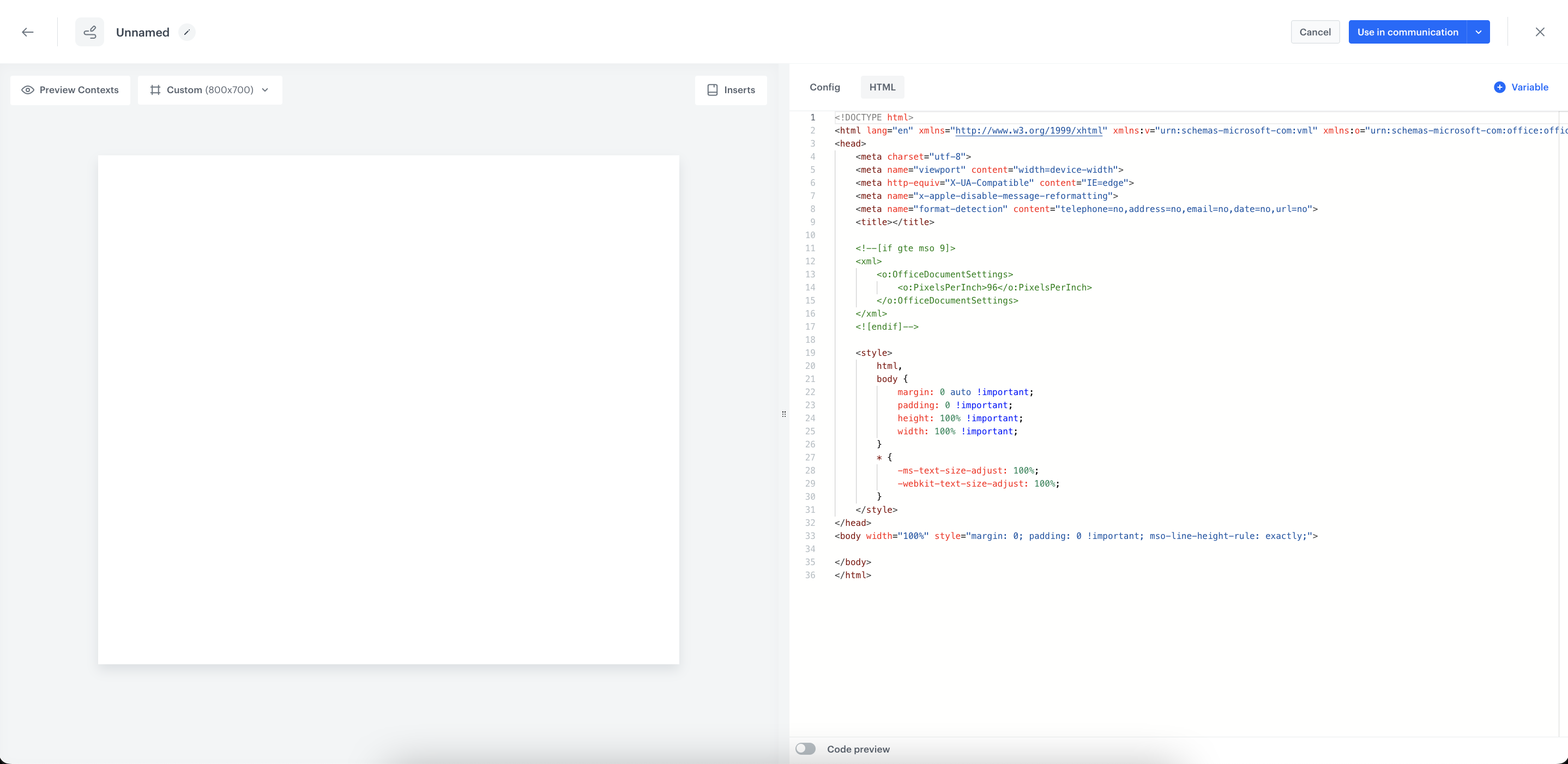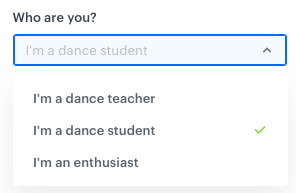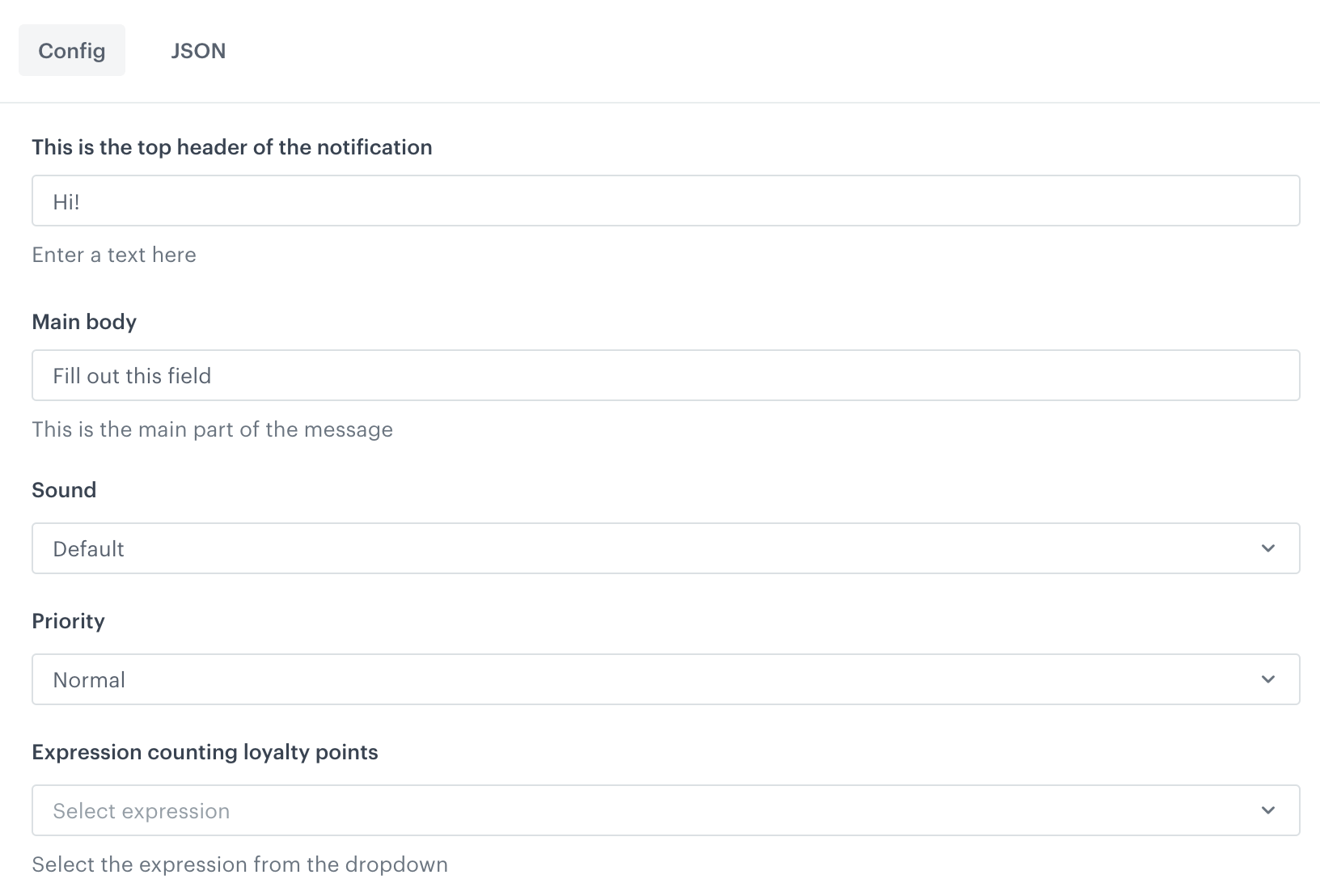Using the email template builder
The email code editor allows you to:
- create email templates from scratch and edit them by using HTML.
- create email templates to be edited in an easy-to-use configuration form that doesn’t require programming skills.
- use the ready-made templates from the Predefined dynamic templates folder as a base for your own designs
The folders with predefined templates provide you with templates for the most common campaign scenarios such as AI recommendations, abandoned cart, recommendations based on the context of the last seen item, and so on.
Using the predefined templates doesn’t require making changes to the template code. The template builder contains a user-friendly configuration form for defining the properties of the template. This makes editing templates possible by any user, regardless of their programming skills.
You can also simplify the editing of your own templates by creating a custom configuration form adjusted to your needs. Thanks to this, you can edit your template or create its variations dedicated for different scenarios.
You can personalize the content of the message by using snippets and Jinjava inserts to inject data such as profile attributes (for example, name), recommendations, analysis results.
Snippets also let you re-use the same content in multiple templates, or create a reference to a fragment that you only need to update in one place to see the change in all templates where it’s used.
Additionally, when you create an email template from scratch, the HTML section contains a default email structure.
Tips before you start
- You can create an email template directly while sending an email. However, because of the approval procedure, it is more convenient to create a template and have it approved before defining the settings while sending an email as it speeds up the process of creating the email.
- While creating the template, save your template once in a while because there is no auto-save option.
- Although Synerise automatically adds the unsubscribe header, always add the resignation link to the template - without it, the emails may reach the spam folder.
- You can use email inserts to not only personalize the contents of the message but also to add such features as tracking click events and UTM parameters to redirecting URLs, or opening a message in the browser
- The View in browser link doesn’t work in the preview. You must send a test email to test such links.
Important: We do not recommend adding a View in browser link to templates that contain a reference to Automation event context (
event.params.{paramName}) because previewing such messages is not supported. - For better template organization, you can create template folders:
- Go to
 Communication > Email.
Communication > Email. - On the left side, click Templates.
- Select From template tab.
- Scroll down to the bottom of the page.
- Click
 Result: A pop-up appears.
Result: A pop-up appears. - On the pop-up, in the Folder name, enter the name of the folder.
- Confirm by clicking Apply.
- Go to
Editing a predefined template
This section describes how to edit the predefined templates (static and dynamic). As a result of editing a predefined template, a copy of a predefined template will be created. Overwriting a predefined template is impossible.
- Go to
 Communication > Email.
Communication > Email. - On the left pane, select Templates.
- From the list of template folders, select Predefined dynamic templates.
- Select one of the templates to edit.
Result: You are redirected to the code editor. - You can edit the template in two ways:
- Edit the code of the template (add inserts, add variables).
- Go to the Config tab and fill out the form.
- After you make changes to the template, you can check the preview.
- When the template is ready, in the upper right corner click Save this template > Save as.
- On the pop-up:
- In the Template name field, enter the name of the template.
- From the Template folder dropdown list, select the folder where the template will be saved.
- Confirm by clicking Apply.
Creating a template

- Go to
 Communication > Email.
Communication > Email. - On the left pane, select Templates.
- In the upper right corner, click New Template.
- Use the HTML tab to define the properties of the template.
- When the template is ready, in the upper right corner click Save this template > Save as.
- On the pop-up:
- In the Template name field, enter the name of the template.
- From the Template folder dropdown list, select the folder where the template will be saved.
- Confirm by clicking Apply.
Adding a snippet to the template code
Snippets let you:
- insert data such as profile attribute, recommendations, or analysis results into the communication.
- create re-usable pieces of static content, so you don’t need to manually copy and paste between templates.
- create dynamic pieces of content that are updated in all templates when you update the snippet definition.
- Click Snippets.
Result: The snippet widget opens. - Add a snippet as described in Snippets.
Template editing simplification
To make your template more accessible to users without programming skills, you can add a configuration form with variables dedicated for the template, so the user can make adjustments to the template.
The effect of template editing simplification is that you can edit templates by filling out a user-friendly configuration form (available in the Config tab) whose fields define the value for each property of the template.
The process of template simplification involves replacing values with variables in the HTML elements, such as alignment, font, color in CSS, or HTML tags as title, description or buttons. You can also add a variable in the place of Jinjava elements, such as a recommendation campaign ID, voucher pool ID, or catalog name. Variables inserted in the code appear in a form the Config tab when editing the template.
List of variables
| Variable name | Description | Example output |
|---|---|---|
| Synerise insert select | Allows you to add a dropdown list with aggregates, expressions, metrics, voucher pools, recommendations, files, catalogs, or attributes. |  |
| String | Allows you to add a field that requires a string value. |  |
| Select | Allows you to add a dropdown list with configurable values. |  |
| Switch | Allows you to add a field which is enabled/disabled by a toggle. |  |
| Color | Allows you to add a color selector. You can either select a color or enter its code manually. |  |
| Number | Allows you to add a field that requires a number. You can either select a number from a dropdown or enter it manually. |  |
Results of simplifying template editing
Instead of modifying the design of the template directly in the code, a user can go to the Config tab and define the properties of the template by filling out configuration form.
The image below presents the easy-to-edit form that lets users without coding expertise change the variable values:

Adding a variable
-
Select one of the code editor tabs.
The tabs may be JSON, HTML, CSS, and JavaScript, depending on the communication type. -
Position the cursor in the place where you want to add the variable.
-
On the right side, click + Variable.
Result: A sidebar appears. -
In the Identifier field, enter the ID of the variable.
This will be the title of the field unless you define the Label field.
The first character of the ID can’t be a number. -
From the Type dropdown list, select the type of variable.
Allows you to add a field that requires a string value.
- In the Label (Optional) field, enter the name of the field.
If this field is empty, the name of the field will be taken from the Identifier field. - In the Description (Optional) field, enter a short explanation of the field’s purpose.
- In the Default Value field, enter the default value.
- In the Label (Optional) field, enter the name of the field.
-
If you want to add the variable to a group that can be more easily displayed together in the form:
- Click Variable Group.
- Select or create a group:
- To select a group, click its name.
- To create a group:
- Click Add new group.
- Enter a group name.
- Enter a group ID.
- Click Apply.
Result: On the Config tab, the groups can be collapsed and expanded.
-
In the upper right corner, click Add.
Result: In the template code, a variable appears (it starts with####). It also becomes available on the Config tab. -
Optionally, to modify the order of variables appearing in the configuration form, add the
orderparameter to the variable formula (for example,#### type: "string", id: "string", label: "Text", order: 1 !####).
Previewing templates
- To check the preview of the template for a particular profile, click the Preview contexts button on the upper left side.
- Enter the ID of a profile.
- Click Apply.

